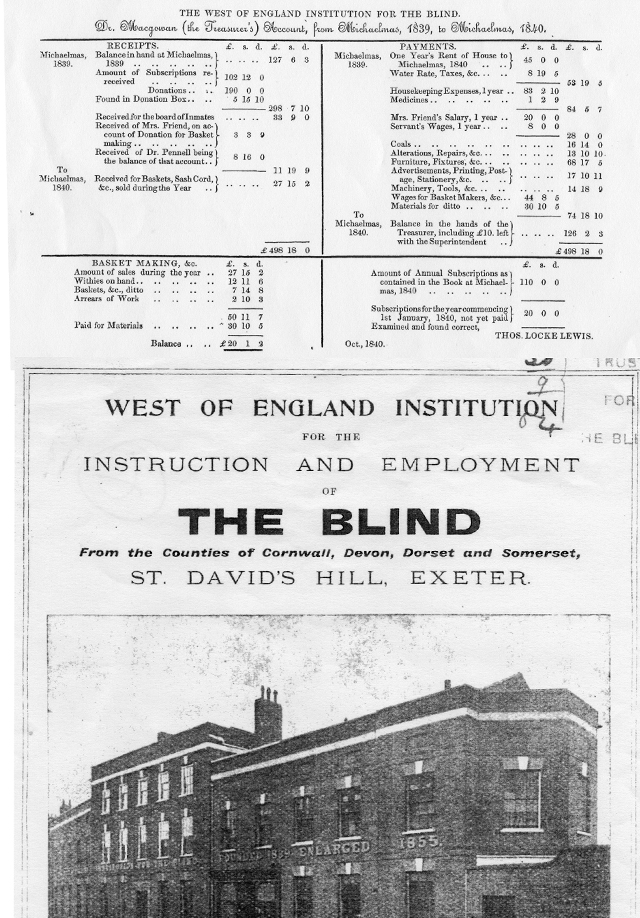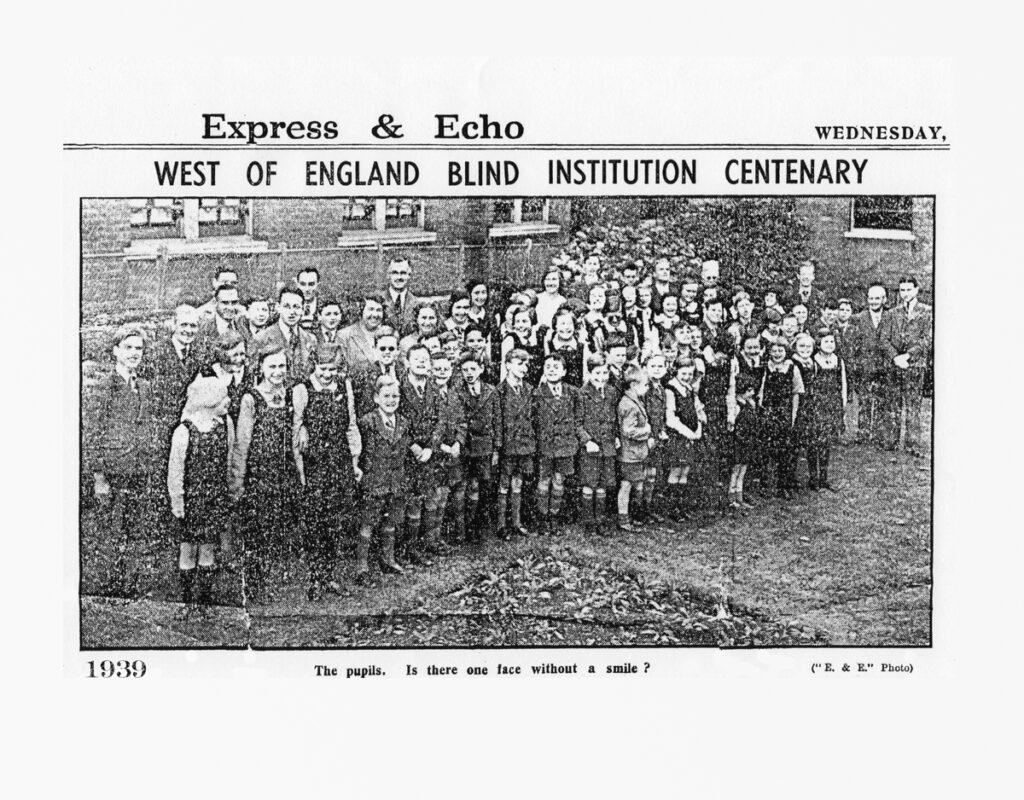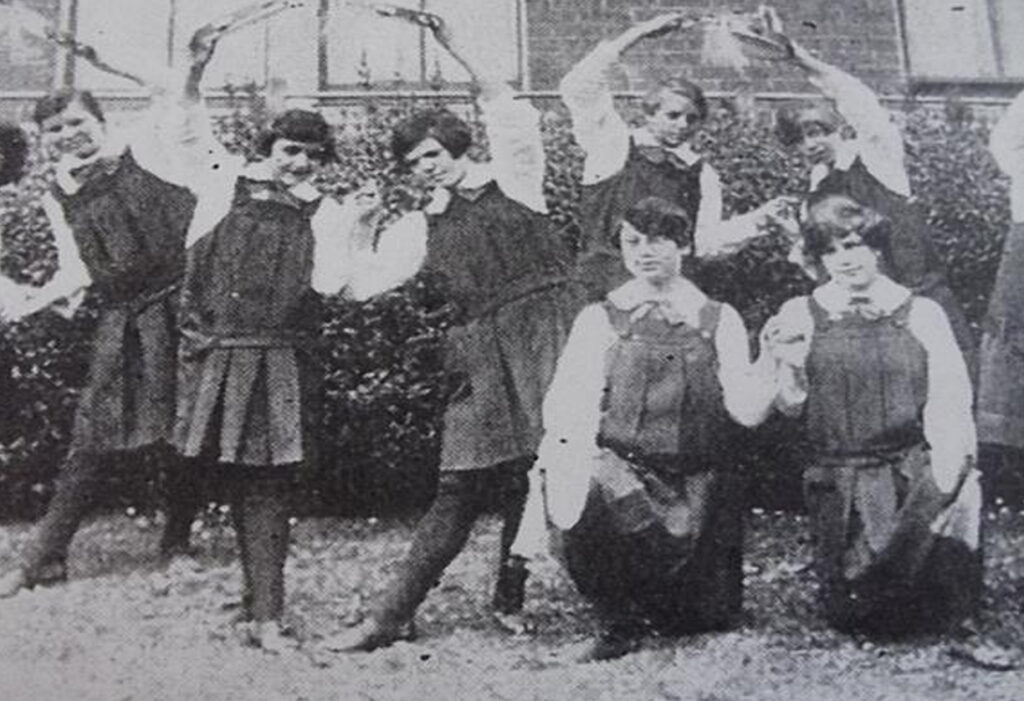Community researcher, Jayne Bray
In 1838 Mrs Sarah Elizabeth Friend, who had devised a system to help the blind read, began providing elementary education at her own expense for seven day pupils in a rented room in South Street. Pupil numbers increased and she soon moved to a larger room at The Athenaeum in Bedford Circus and later to a rented house in Paul Street. In the 1840s she purchased an eighteenth-century house on St David’s Hill and re-opened her school on 1st March 1843.
The Exeter Indigent Blind Society, as it was called, was built on religious foundations. Pupils were taught to read from the gospels and staff and pupils attended services at the churches of St Martin or St Paul. Music was prominent: a choir was formed, pupils were taught to play the piano and the organ, and concerts were held.
In 1921 a music block was built adjoining the gymnasium. Ballroom dancing was introduced for the girls in the 1920s but the boys were not allowed to attend for another 24 years.
As elsewhere, the school depended upon the generosity of local gentry, land owners and nobility. In 1903 a home visiting and teaching society was set up for the blind in the community.
The subjects taught were similar to those in main stream schools. Originally the students were local day pupils but this was opened up to those further afield when boarding was introduced. Students came from the West Country, although it is noted that in 1916 they came from as far away as London and the Midlands. By the end of the 1950s there were televisions and radios in every classroom.

A history of St Davids Hill 1843-1965
Community researcher, Hannah Reynolds
Workshops provided vocational training for basket making, mat and rug making, plaiting straw, wickerwork, piano tuning and repair. This was extended to include knitting, shoe and boot manufacture and repair and woodwork. Cookery for boys was introduced in 1933. Gardening classes were for boys from rural areas, supplying fruit and vegetables to the school kitchen. The boys joined the young farmers. A willow bed in The Bonhay provided materials. In the 1950s and 1960s contact with the outside world was encouraged and work experience, road safety and first aid were included.

Over the years social activities were introduced including swimming at the local baths, Girl Guides, Scouts, Brownies, football, summer camps, sports days and trips to the seaside. The school owned a beach hut at Dawlish.
In the early 1950s a train spotting group was formed. In the evening the students would be able to play chess, skittles or spend their time reading and sewing (using the schools sewing machines) to make their own clothes or to sell. In 1954 the school got a tuck shop and a dramatic society was formed along with a Meccano club. The first school trip abroad was in the 1960s.
The school was supported by fees, gifts, legacies and fund-raising events. Workshop items were sold at Higher Market in Queen Street. The quality was of such a high standard there were orders from as far away as New Zealand.
As the school grew, workshops, dormitories and classrooms were built on.
In 1893 a fully equipped gymnasium was added, later a sickroom and rooms for dental, health and ophthalmic appointments were provided. Around 1900, an imposing new shop front replaced the old one to offer a fine window display.
In 1910 a nursery school opened. In 1913 a classroom with a verandah was built for open air teaching. In 1948, with the reduction of production and sale, the workshop was moved out to George Street and the vacated areas used for a theatre, library and handicraft room. In the early 1930s gas was replaced by electric.
During the First World War a playing field was turned into a potato field. The committee was reduced as a number were called up. The knitting department saw a demand for socks and stockings, and the Government requested large quantities of belts, scarves and mittens for the armed forces.
More building work was completed and outside fire escapes provided.
In 1913 a new building was opened to provide continuation classes for those aged 16 to 21 in order to bridge the gap between leaving school and employment. Girls were instructed in the laundry and kitchen while boys worked in boot and shoe repair.

In the Second World War some staff were called up and windows in the gymnasium had minor damage when a fire bomb fell in Dinham Road. Many blind adults and children were evacuated to the school from London. Two air raid shelters were built and the accommodation altered inside. There were difficulties in obtaining materials and restrictions were put on production. Poultry and bee-keeping was introduced.
In the late 1940s the blind pupils were moved to the Bristol school and it became the West of England School for the Partially Sighted. Other departments however continued to provide for adults. In 1953 a thirteen acre site was purchased at Countess Wear. The foundation stone was laid in 1963 and the building opened two years later.